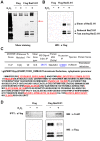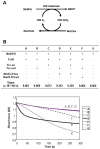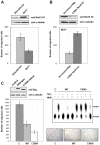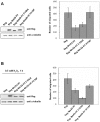Multiple functions of Nm23-H1 are regulated by oxido-reduction system
- PMID: 19956735
- PMCID: PMC2776532
- DOI: 10.1371/journal.pone.0007949
Multiple functions of Nm23-H1 are regulated by oxido-reduction system
Abstract
Nucleoside diphosphate kinase (NDPK, Nm23), a housekeeping enzyme, is known to be a multifunctional protein, acting as a metastasis suppressor, transactivation activity on c-myc, and regulating endocytosis. The cellular mechanisms regulating Nm23 functions are poorly understood. In this study, we identified the modifications and interacting proteins of Nm23-H1 in response to oxidative stress. We found that Cys109 in Nm23-H1 is oxidized to various oxidation states including intra- and inter-disulfide crosslinks, glutathionylation, and sulfonic acid formation in response to H(2)O(2) treatment both in vivo and in vitro. The cross-linking sites and modifications of oxidized Nm23-H1 were identified by peptide sequencing using UPLC-ESI-q-TOF tandem MS. Glutathionylation and oxidation of Cys109 inhibited the NDPK enzymatic activity of Nm23-H1. We also found that thioredoxin reductase 1 (TrxR1) is an interacting protein of Nm23-H1, and it binds specifically to oxidized Nm23-H1. Oxidized Nm23 is a substrate of NADPH-TrxR1-thioredoxin shuttle system, and the disulfide crosslinking is reversibly reduced and the enzymatic activity is recovered by this system. Oxidation of Cys109 in Nm23-H1 inhibited its metastatic suppressor activity as well as the enzymatic activities. The mutant, Nm23-H1 C109A, retained both the enzymatic and metastasis suppressor activities under oxidative stress. This suggests that key enzymatic and metastasis suppressor functions of Nm23-H1 are regulated by oxido-reduction of its Cys109.
Conflict of interest statement
Figures









Similar articles
-
Structure of Nm23-H1 under oxidative conditions.Acta Crystallogr D Biol Crystallogr. 2013 Apr;69(Pt 4):669-80. doi: 10.1107/S0907444913001194. Epub 2013 Mar 14. Acta Crystallogr D Biol Crystallogr. 2013. PMID: 23519676
-
Oxidative modification of nucleoside diphosphate kinase and its identification by matrix-assisted laser desorption/ionization time-of-flight mass spectrometry.Biochemistry. 2000 Aug 22;39(33):10090-7. doi: 10.1021/bi000267a. Biochemistry. 2000. PMID: 10955997
-
Activation of Nm23-H1 to suppress breast cancer metastasis via redox regulation.Exp Mol Med. 2021 Mar;53(3):346-357. doi: 10.1038/s12276-021-00575-1. Epub 2021 Mar 22. Exp Mol Med. 2021. PMID: 33753879 Free PMC article. Review.
-
Metastasis suppressor NM23 limits oxidative stress in mammals by preventing activation of stress-activated protein kinases/JNKs through its nucleoside diphosphate kinase activity.FASEB J. 2017 Apr;31(4):1531-1546. doi: 10.1096/fj.201600705R. Epub 2017 Jan 11. FASEB J. 2017. PMID: 28077425
-
The multiple regulation of metastasis suppressor NM23-H1 in cancer.Life Sci. 2021 Mar 1;268:118995. doi: 10.1016/j.lfs.2020.118995. Epub 2021 Jan 6. Life Sci. 2021. PMID: 33421524 Review.
Cited by
-
Characterization of Functional Domains in NME1L Regulation of NF-κB Signaling.Mol Cells. 2016 May 31;39(5):403-9. doi: 10.14348/molcells.2016.2320. Epub 2016 Apr 4. Mol Cells. 2016. PMID: 27094059 Free PMC article.
-
Histidine Phosphorylation: Protein Kinases and Phosphatases.Int J Mol Sci. 2024 Jul 21;25(14):7975. doi: 10.3390/ijms25147975. Int J Mol Sci. 2024. PMID: 39063217 Free PMC article. Review.
-
Substrate specificity and nucleotides binding properties of NM23H2/nucleoside diphosphate kinase homolog from Plasmodium falciparum.J Bioenerg Biomembr. 2010 Oct;42(5):361-9. doi: 10.1007/s10863-010-9304-9. Epub 2010 Aug 17. J Bioenerg Biomembr. 2010. PMID: 20711856
-
A preliminary X-ray study of human nucleoside diphosphate kinase A under oxidative conditions.Acta Crystallogr Sect F Struct Biol Cryst Commun. 2010 Nov 1;66(Pt 11):1490-2. doi: 10.1107/S1744309110036067. Epub 2010 Oct 28. Acta Crystallogr Sect F Struct Biol Cryst Commun. 2010. PMID: 21045303 Free PMC article.
-
ROSics: chemistry and proteomics of cysteine modifications in redox biology.Mass Spectrom Rev. 2015 Mar-Apr;34(2):184-208. doi: 10.1002/mas.21430. Epub 2014 Jun 10. Mass Spectrom Rev. 2015. PMID: 24916017 Free PMC article. Review.
References
-
- Rosengard AM, Krutzsch HC, Shearn A, Biggs JR, Barker E, et al. Reduced Nm23/Awd protein in tumour metastasis and aberrant Drosophila development. Nature. 1989;342:177–180. - PubMed
-
- Nakayama T, Ohtsuru A, Nakao K, Shima M, Nakata K, et al. Expression in human hepatocellular carcinoma of nucleoside diphosphate kinase, a homologue of the nm23 gene product. J Natl Cancer Inst. 1992;84:1349–1354. - PubMed
-
- Steeg PS, Bevilacqua G, Kopper L, Thorgeirsson UP, Talmadge JE, et al. Evidence for a novel gene associated with low tumor metastatic potential. J Natl Cancer Inst. 1988;80:200–204. - PubMed
-
- Steeg PS. Metastasis suppressors alter the signal transduction of cancer cells. Nat Rev Cancer. 2003;3:55–63. - PubMed
-
- Leone A, Flatow U, VanHoutte K, Steeg PS. Transfection of human nm23-H1 into the human MDA-MB-435 breast carcinoma cell line: effects on tumor metastatic potential, colonization and enzymatic activity. Oncogene. 1993;8:2325–2333. - PubMed
Publication types
MeSH terms
Substances
LinkOut - more resources
Full Text Sources
Other Literature Sources
Research Materials

